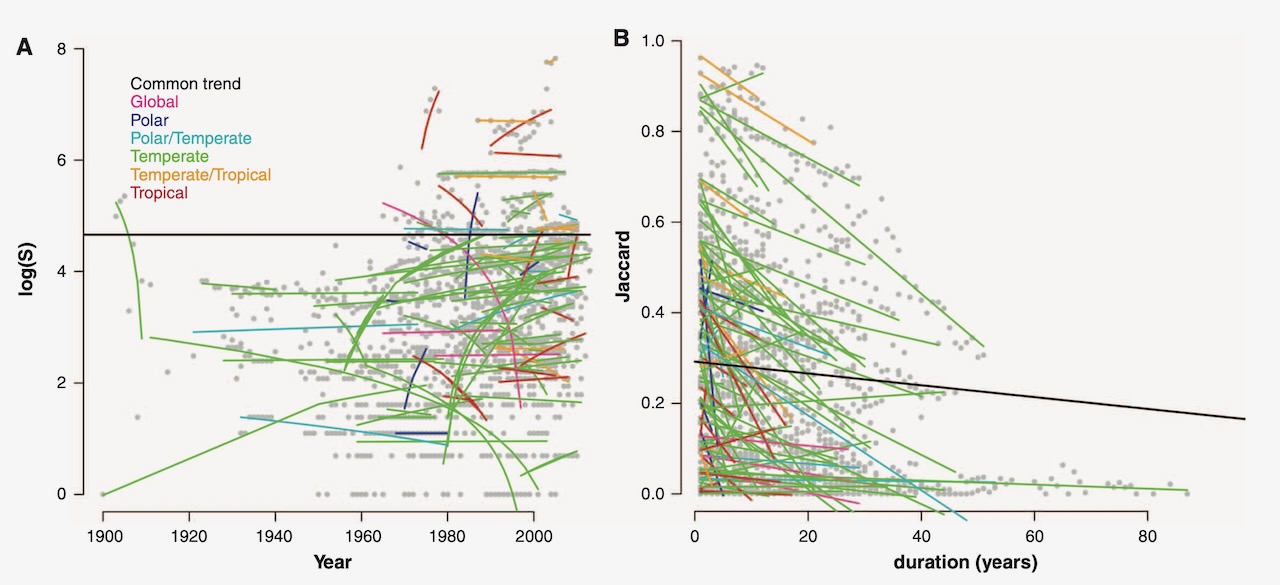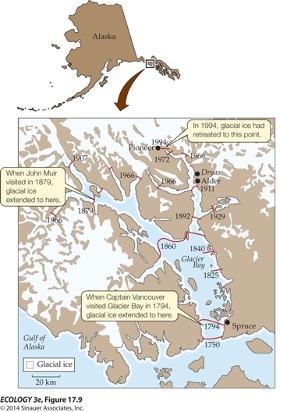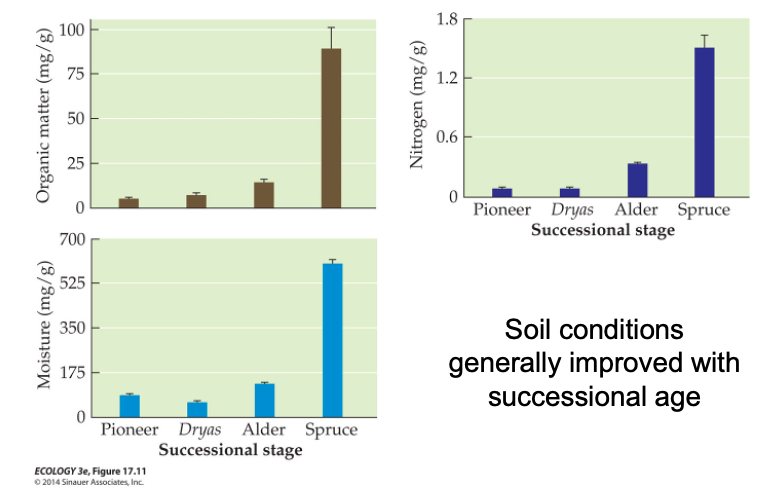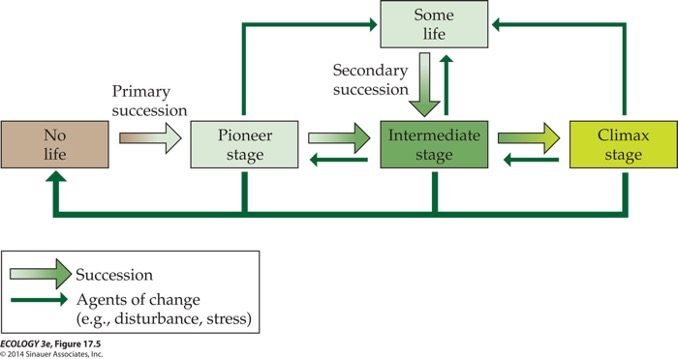class: center, middle, inverse, title-slide .title[ # Ecological communities ] .author[ ### Daijiang Li ] .institute[ ### LSU ] --- class: left, middle class: left, center, inverse .font300[Announcements] + + + --- class: center, middle, inverse .font200[ Even though I have separate sections on Competition and Predation in the course, I don't have one on Mutualism. Mutualism is important ecologically, but often each mutualism is important for a different reason. Mutualisms are often very specific for the types of organisms that are involved. .cyan[Because mutualism is caused by co-evolution, a lot of them have their own idiosyncrasies that don't generalize easily to a way of explaining the overall things that are common to mutualisms]. This is a contrast to Competition and Predation where there are a lot of features common to the interactions between very different pairs of species. ] --- # Levels of organization in Ecology  --- # What is an ecological community? Community – collection of species that occur at the same place & time, circumscribed by natural (e.g., serpentine soil), arbitrary, or artificial (e.g., 1-m2 quadrat) boundaries  ??? An ecological community is a set of interacting species which utilize the same environment. --- # What is an ecological community? Community – an association of .blue[interacting] species inhabiting a defined area whose interactions can be + or - & direct or indirect.  --- # Community Ecology ## Major focus .font200[ - How are groupings of species distributed in nature? (e.g., diversity) - How are these groupings explained by the environment and the interactions between and among species? ] --- background-image: url('../13_macroecology/figs/ldg.jpeg') background-position: 50% 50% background-size: contain class: center, top, inverse # Biodiversity --- # Calculating Biodiversity ### There are multiple ways to calculate biodiversity: .font200[ - Species diversity - Genetic diversity - Ecosystem diversity ] --- # Species diversity .font200[alpha, beta, and gamma diversity]  --- # Measuring alpha species diversity .font150[One of the most common measurement is .blue[species richness], the number of species in a community]  .font150[.red[What is the species richness for both communities?]] --- # Species Richness .font200[ Impossible to count all species .red[Need to estimate based on sampling (quadrats, plots, transects, traps, etc.)] Richness depends on number of samples collected .red[More samples → more species] ] --- # Species Richness  --- # Species Richness .center[  ] .font150[ Use extrapolation to predict richness - Want to predict the asymptote - Try to collect as few samples as possible ] ??? - with a few samples, you collect mostly common species - with more samples, you start to collect some of the rarer species - only with intensive sampling do you start to collect all species - unless you’ve sampled enough to reach this plateau, beyond which no new species are added, you will miss species - biological inventories conducted by Nature Conservancy and others rely on extrapolation - try to predict the asymptote. Also try to collect as few samples as possible to achieve that asymptote --- # Rarefaction .font200[Individual-based and sample-based Procedures of individual-based rarefaction Use rarefaction to compare diversity between two sites with different sampling effort ] .center[] --- # Rarefaction Assumptions .font200[ + underlying community is constant over time (no immigration or emigration of species) + well-mixed community (spatial distribution of each species is random) + individuals are sampled at random (brighter colored individuals aren't sampled more often than others) + sampling with identical methods (if used to compare two communities) ] --- # Approximation .font200[ `$$E(S_{m}) \approx S - \sum_{i=1}^{S}(1-p_{i})^{m}$$` where `\(S\)` is the number of species, `\(m\)` is the total number of individuals in the sample, and `\(p_i\)` is the proportion of species `\(i\)` in the original sample. ] --- # Species richness estimators for extrapolation ## Chao1 index .font200[ `$$S_{est} = S_{obs} + \left( \frac{(f_{1})^{2}}{2f_{2}}\right)$$` ] --- class: middle, left .font200[ If a sample of an ecological community results in the following abundances of species, what is the estimated overall richness of the community? Sp A (200 individuals), Sp B (140 individuals), Sp C (98 individuals), Sp D (30 individuals), Sp E (2 individuals), Sp F (2 individuals), Sp G (1 individual), Sp H (1 individual). A. 8 B. 9 C. 10 D. 11 ] --- # Problem of Species Richness  .font200[.red[Which community is more diverse??] .blue[Richness is an uninformative descriptor: equal weight given to rare and abundant species] ] --- # Commonness vs. Rarity in communities .font150[The typical pattern of abundances of different species of a single group in the same area:] <img src="presentation_files/figure-html/unnamed-chunk-1-1.png" width="60%" style="display: block; margin: auto;" /> --- # Species abundance  .font150[ - Moth data from England - x-axis on log2 scale; - Partial bell-shaped curve -- .blue[log-normal distribution] - .red[Very common pattern in nature] ] --- # Species Diversity  .font150[.red[Given the commonness of rarity, how to measure community diversity?]] .pull-left[ .font150[ Two different things going on: - Species Richness (number of species) - Species Abundance (relative evenness) ] ] .pull-right[ .font150[ Two potential solutions: - Shannon Index - Rank-abundance Curves ] ] --- # Shannon Index .font200[ Balancing Richness and Abundance/Evenness `$$H' = - \sum_{i=1}^{S}p_i\ln p_i$$` Where: `\(p_i\)` = proportion of the total sample represented by species `\(i\)`, `\(\ln\)` = log base `\(e\)`, `\(S\)` = the number of species in the community ] --- # Shannon Index .font130[ `\(H' = - \sum_{i=1}^{S}p_i\ln p_i\)` ]  .pull-left[ | Species | Abundance | Pi | ln(Pi) | Pi x ln(Pi) | |---------|-----------|----|--------|-------------| | Yellow | 17 | | | | | Orange | 1 | | | | | Purple | 1 | | | | | Brown | 1 | | | | | Total | 20 | 1 | | | .font150[H' = ?] ] .pull-right[ | Species | Abundance | Pi | ln(Pi) | Pi x ln(Pi) | |---------|-----------|----|--------|-------------| | Yellow | 5 | | | | | Orange | 5 | | | | | Purple | 5 | | | | | Brown | 5 | | | | | Total | 20 | 1 | | | .font150[H' = ?] ] --- background-image: url('figs/shannon.png') background-position: 50% 50% background-size: contain class: center, bottom .font200[Index Higher when species more evenly distributed] ---  .font150[ What is the Shannon Index of Diversity for the following community? A. 0 B. 1 C. 2.83 D. 17 ] ??? Prop = 1, and ln1 = 0. Therefore, it’s 0. --- # Shannon Index .font200[ Weakness - Can’t tell if differences in measurements are due to richness or evenness (or can you?) - Difference between 0.58 & 1.39. What does it mean? When all species are equally abundant: `\(H' = \ln (4) = 1.39\)`: Community B has max diversity Evenness E = H'/H'max ] --- # Rank-Abundance Curve <img src="presentation_files/figure-html/unnamed-chunk-2-1.png" width="60%" style="display: block; margin: auto;" /> .font150[Slope ≈ evenness; Length ≈ richness] --- # Rank-Abundance Curve .font150[Slope ≈ evenness; Length ≈ richness. .blue[Most species are moderately abundant; few are very abundant or extremely rare]] .center[] --- # Beta diversity ## To compare diversity between communities .font200[ Jaccard similarity: $$ J(A,B) = \frac{| A \cap B |}{| A \cup B|} $$ `\(| A \cap B |\)` is the shared species between communities `\(A\)` and `\(B\)`, while `\(| A \cup B |\)` is the total number of shared and non-shared species. ] --- # Beta diversity ## There are many other beta diversity indices .font200[ [Measuring beta diversity for presence–absence data](https://besjournals.onlinelibrary.wiley.com/doi/10.1046/j.1365-2656.2003.00710.x) It reviewed 24 such measures! ] --- # Distance-decay in community similarity .font150[ A common observation: communities which are farther apart tend to be more dissimilar than two communities which are close together ] .center[] --- # How have alpha and beta diversity changed over time? .font200[ [Assemblage Time Series Reveal Biodiversity Change but Not Systematic Loss](https://www.science.org/doi/10.1126/science.1248484) ]  --- # How have alpha and beta diversity changed over time? .font150[[Changes in taxonomic and phylogenetic diversity in the Anthropocene](https://royalsocietypublishing.org/doi/10.1098/rspb.2020.0777)]  --- # Community composition .font200[Community composition describes the **diversity and identity** of species within a given community .blue[_keystone species_] is a species that has a large impact on community structure relative to it's abundance / biomass in the community (e.g., top predator) .blue[_foundation species_] is a species that can play a substantial role in determining what species can exist within the community (e.g., beavers, earthworms). Usually, this is a species that defines much of the structure of a community through e.g., habitat-forming ] --- background-image: url('figs/assembly.png') background-position: 90% 50% background-size: contain class: left, top .pull-left[ # Community assembly .font200[_Community assembly_ is the set of processes by which communities are formed] .font150[Whereas the figure is drawn as if these processes occur sequentially, in reality they occur more-or-less simultaneously or in any order] ] --- # Succession, Disturbance & Stress .font150[ **Succession** – directional change in community composition at a site (as opposed to simple fluctuations), initiated by natural or anthropogenic disturbance, stress, or the creation of a new site Some biologists restrict the definition to directional replacement of species after disturbance **Disturbance** – a discrete event that damages or kills residents on a site (and potentially creates opportunities for other individuals to grow or reproduce); either catastrophic or non-catastrophic (Platt & Connell 2003 Ecological Monographs) **Stress** – factor that reduces growth, reproduction, or survival of individuals (and potentially creates opportunities for other individuals) ] --- # Scales of Disturbance .font150[Intensity & Severity (how much damage & death?); Frequency (how often?); Extent (how much area was affected?)] .center[] --- # Disturbance & Succession .font150[Primary Succession – succession that occurs after the creation of a “blank slate,” either through catastrophic disturbance or _de novo_ creation of a new site] .center[  ] --- # Disturbance & Succession .font150[Secondary Succession – succession that occurs after non-catastrophic disturbance (including “old fields”)] .center[  ] --- # Primary successsion example .pull-left[ ## Primary succession along the Glacier Bay chronosequence .font150[ One of the world’s most rapid and extensive glacial retreats in modern times (so far); eliminated ~2500 km2 of ice in ~200 yr, exposing large expanses of nutrient-poor boulder till to biotic colonization ] ] .pull-right[  ] --- # Primary succession along the Glacier Bay chronosequence .pull-left[ .font200[ Reconstructed patterns of stand development at several sites within the chronosequence; intensively analyzed tree-rings ] ] .pull-right[  ] --- # Primary succession along the Glacier Bay chronosequence  --- # Primary succession along the Glacier Bay chronosequence .pull-left[ .font200[ Species richness generally increased with successional age (a common pattern in succession studies, even though at times a mid-succession peak is observed) ] ] .pull-right[  ] --- # Primary succession along the Glacier Bay chronosequence  --- background-image: url('figs/sec_suc.png') background-position: 50% 50% background-size: contain class: right, top # Secondary succession --- background-image: url('figs/turner.png') background-position: 50% 50% background-size: contain class: right, top --- background-image: url('figs/yellowstone.png') background-position: 50% 50% background-size: contain class: right, top --- # Disturbance & Succession .center[] --- class: middle # Disturbance & Succession .pull-left[ .font150[ .blue[Henry Chandler Cowles (1869-1939)] Lake Michigan sand dunes – late 1800s Concluded that sites on the dunes were older further inland, i.e., formed a “chronosequence” (also space-for-time substitution) from which temporal change could be inferred Referred to distinct plant assemblages as “societies” ] ] .pull-right[  ] --- # Succession: superorganism or individualism? .pull-left[ ## Frederic E. Clements (1874-1945) .font200[ Radical, “.blue[superorganism]” view of communities; species interact and act _en masse_ to promote a directed pattern of community development through “seral” (intermediate) stages, ending in a “climax” community ] ] .pull-right[ ## Henry A. Gleason (1882-1975) .font200[ “.blue[individualistic view of succession]” in which “every species is a law unto itself” ] ] --- .center[] .font200[Our modern population-biology view derives primarily from Gleason’s conceptual model, even though Clementsian ideas of deterministic progression through seral to climax stages dominated ecological theory well into the 20th century] --- # Why aren't all communities predictable? ## Historical contingency or priority effects ## Stochasticity